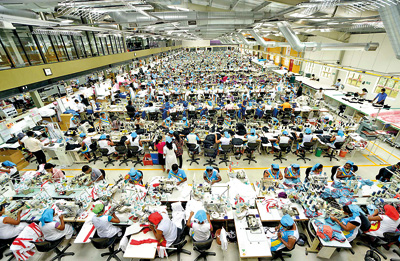Textile and clothing factories decline in Sri Lanka
View(s):Textile and clothing factories in Sri Lanka have declined over the past decade whilst there has been a growth in other South Asian countries and their products are more competitive than those in Sri Lanka, lamented a top industry official.

File picture of a garment factory in Sri Lanka.
Chairman of the Textile Institute Sri Lanka Section, Prof. Rohana Kuruppu, addressing the membership and textile industrialists at its 45th AGM held recently at Berjaya Mount Royal Hotel, said that Sri Lanka had a slow growth in textile/clothing exports and reached US$5 billion in exports in 2018.
The total US textile and clothing imports have been $111 billion in 2018. The US imports of textile and clothing increased in value by 4.9 per cent and in volume terms imports rose by 5.9 per cent in 2018.
“The total volume of textile and clothing reached 68.5 billion square metre equivalent (sme) in 2018. This is an indication that textile and clothing accounted for a noticeable share of total imports to the US which is good news for clothing exporters in the world,” he said.
Sri Lanka’s total textile and clothing exports were up by 5.7 per cent in 2018 and out of this export of clothing alone increased by 4.7 per cent in 2018 over 2017.
While other partners in the South Asian region are better positioned in terms of growth, Sri Lanka will need to strategise her production to stay alive in this competition. Sri Lanka’s largest export market for textiles and clothing was to the EU in 2018 with an estimated share of 36 per cent and the second largest market for its exports in 2018 was the US with an estimated 33 per cent share of Sri Lanka’s textile and exports to all destinations in 2018. The largest market for Bangladesh’s clothing exports in 2018 was the EU with 62.5 per cent share and second was the US with 17.8 per cent share to all destinations.
He said the average price of US textile and clothing imports fell in 2018 for the seventh year in succession to a record low of $1.62 per square metre equivalent. Over the seven years to 2018 the average import price declined by a total of 14.2 per cent with one of the reasons for this decline being China dropping its prices. Textile Outlook International UK predicts that the average price of textiles and clothing imports into the US is expected to rise in 2019 due to the increase in fibre prices.
The US textile and clothing imports from China were up by 4.8 per cent in value and by 6.7 per cent in volume. As a result, the share of US textile and clothing imports which came from China rose in volume terms to 49.3 per cent and value terms it accounted for 36.5 per cent.
Cambodia gained a share in the US import market while imports from Bangladesh, India and Vietnam also rose in value and volume although the rises were not significant.
Therefore, the real challenge is to be competitive and yet increase the market share of value and volume significantly. “So, the question is, how do we do that,” asked Prof. Kuruppu. It is easily said than done. He said he didn’t believe that simply increasing the efficiency and thus improving the productivity will do the trick.
“We need to bring in a new broad perspective, a paradigm shift! Our supply chain practices need a new look. The craftsmanship must be perfect and our products should be branded labels. Professional ethics and relationships must be improved,” he said.
“In today’s context we must understand, that we are living in a radical state of uncertainty. Heightened demand for volatility, geopolitical risks, natural disasters, terrorist attacks, social media disruptions are all taking their toll on global supply chain. The changes are inevitable to disrupt the textile supply chains. We need to create a knowledge hub with emerging technologies and innovations such as AI and advancements in material science coupled with digitalisation, big data and analytics to create the perfect platform for modern day business,” he added.
Prof. Kuruppu emphasised that changes are need to keep the industry moving forward.
“The world is on the verge of a change and this change will have implications on the way we do business in the future. The ways in which we design, source, manufacture and deliver must be redesigned, if we are truly to keep alive our textile industry. A new policy for textile and clothing must be developed and steps must be taken to implement it . All stakeholders must converge to support to make the change and carry it forward,” he said.


